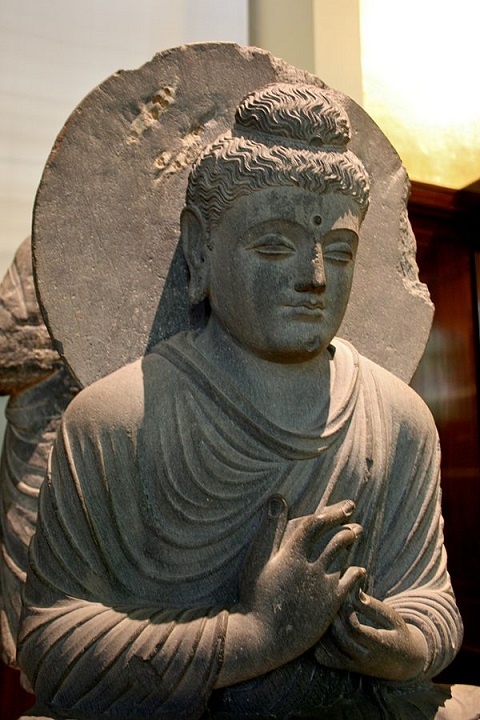| THE KEY IDEAS |
| 1. Discovery of the way to be happy and blissful in the world filled with pain and sorrow: Key focus on human happiness and wellbeing – no inflexible dogma, no commandments, no creation theory, no fixed worldview or metaphysics, not any absolute entity whatsoever either – Lord Buddha discovered the way to be happy and blissful in the world filled with pain and sorrow. He employed causal analysis for the first time in the history of mankind to diagnose and arrive at solution for the pervasive suffering manifested mainly as mental agonies or illnesses in the form of disappointments, insecurities of life, depression and anxieties triggered by all the continuous changes taking place in one’s life course including ageing, poor health conditions and loss of loved ones etc. He found that life is actually blissful. There is joy everywhere. But the bliss or the joy is in transitoriness; the bliss could be found in the fleeting moment through the practice of meditation. The recognition and appreciation of the ‘temporariness’ of everything in life is the starting point followed by the cognition or the conscious awareness of the causative factors behind mental suffering and the cultivation of mind to come to terms with the realities of thoughts and desires. Conscious awareness of the factors causing mental suffering and cultivating mind for mindfulness (i.e., awareness of the moment) are keys to freedom from pervasive suffering. We must always be aware of the moment we are in because it is this moment there is beauty of life. 2. Code for human behaviour independent of faith and belief system: Buddha provided the code for human behaviour independent of faith and belief system; how human should behave no matter whether there is God or not. He had changed the concept of karma from ritual action to the intent behind action thereby opening the door for improvement to all classes of the society. 3. Individual empowerment through reasoning and rational thinking: Lord Buddha championed individual empowerment through reasoning and rational thinking. In Kalama Sutta, he said ”Do not believe in anything (simply) because you have heard it. Do not believe in traditions because they have been handed down for many generations. Do not believe in anything because it is spoken and rumoured by many. Do not believe in anything (simply) because it is found written in your religious books. Do not believe in anything merely on the authority of your teachers and elders. But after observation and analysis, when you find that anything agrees with reason and is conducive to the good and benefit of one and all, then accept it and live up to it’’. |
THE DISCOVERY
Causation & Dependent Origination
इमस्मिम् सति इदं होति, इमस्मुपादा इदम् उप्पज्जति ।
इमस्मिम् असति इदं नहोति, इमस्स निरोधा इदम् निरूज्झति।
Imasmim sati idam hōti, imassa uppādā idam uppajjāti |
imasmim asati idam na hōti, imassa nirōdhā idam nirujjhatī ti ||
When this exists, this naturally exists; Due to the arising of this, this consequently arises.
When this does not exist, this naturally does not exist; Due to the quenching of this, this consequently quenches
Seated Buddha from Gandhara (dates to the 2nd or 3rd century AD ; possibly the oldest statue of Buddha)

|| ॐ बुद्धाय नमः ।।
INTRODUCTION:
The Buddha. HD (English Subtitle)
Genius of the Ancient World Buddha Episode 1 of 3
The Four Noble Truths | Swami Sarvapriyananda
Seven Wonders of the Buddhist World.
Basics of Buddhism by Patrick Goodness
BUDDHISM IN GLOBAL AGE OF TECHNOLOGY:
BUDDHIST ETHICS | Robert Thurman | Talks at Google
A SECULAR BUDDHISM | Secular Buddhism | Lecture by Buddhism scholar and teacher Stephen Batchelor
NATURE OF REALITY:
The Nature of Reality – Theory of Relativity, Quantum Science and Buddhist Thought 1/2
The Nature of Reality – Theory of Relativity, Quantum Science and Buddhist Thought 2/2
The Nature of Reality: A Dialogue Between a Buddhist Scholar and a Theoretical Physicist
Bones Of The Buddha – Full Documentary on Piprahwa discovery by Charles Allen
HINDUISM & BUDDHISM: TWO SIDES OF SAME COIN
KEY TEXTS:
- Tipitaka English Translation from Myanmar Government (DPPS) By Myanmar Government | pdf file
- The Book of the discipline: (Vinaya-pitaka) By Horner, I. B. (Isaline Blew), 1896-1981| pdf file
- The Samyutta-nikaya of the Sutta-pitaka. Edited by M. Léon Feer | pdf file
- Guide Through The Abhidhamma Pitaka By Nyanatiloka Mahathera | pdf file
- The Diamond Sutra: A General Explanation of the Vajra Prajña Paramita Sutra by Dhyana Master Hsüan Hua
- Kalama Sutta or Kesamutti Sutta by Ven. Weragoda Sarada Thero | pdf file
- Dhammacakkappavattana Sutta or First Sermon of The Buddha By Ven. Weragoda Sarada Thero | pdf file
- Maha Parinibbana Sutta By Ven Ajahn Brahmali
- Treasury of Truth The Dhammapada – Text Version by Ven. Weragoda Sarada Thero
- Buddhism The Treasury Of Truth Dhammapada Illustrated | pdf file
- Mahavamsa (The Great Chronicle of Ceylon) By Geiger, Wilhelm | pdf file
INTRODUCTORY TEXTS:
- Essentials of Buddhism
- The Buddhist Core Values by Ven. Phramaha Nopadol Saisuta
- Tipitaka -The Pali Canon. Access to Insight.
- Three Baskets (Tipitaka) in Buddhism
